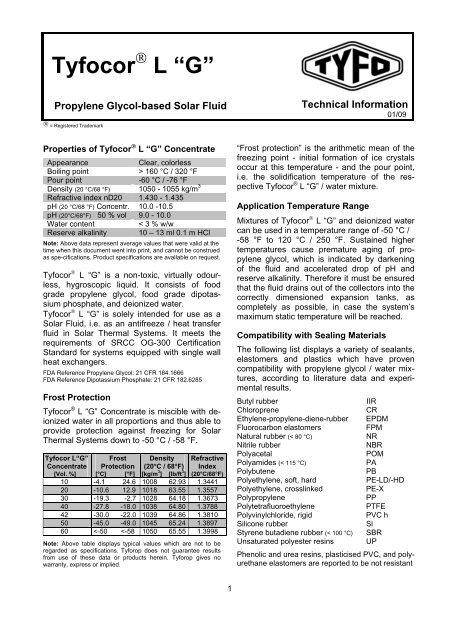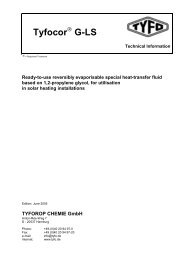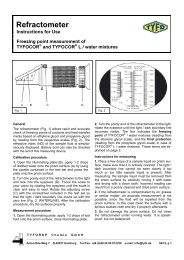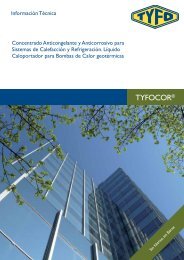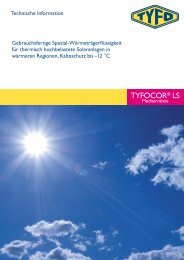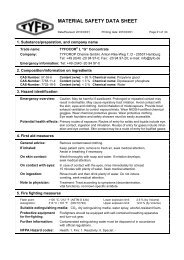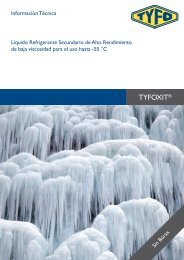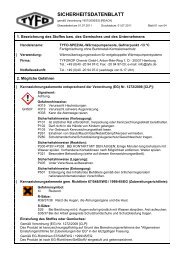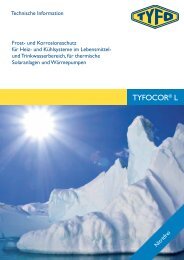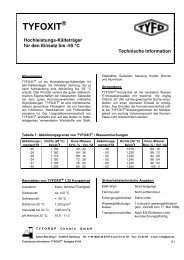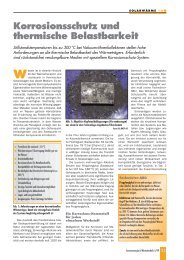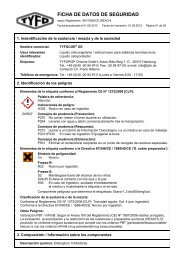Tyfocor L âGâ - Tyforop Chemie GmbH
Tyfocor L âGâ - Tyforop Chemie GmbH
Tyfocor L âGâ - Tyforop Chemie GmbH
Create successful ePaper yourself
Turn your PDF publications into a flip-book with our unique Google optimized e-Paper software.
<strong>Tyfocor</strong> ® L “G”<br />
Propylene Glycol-based Solar Fluid Technical Information<br />
01/09<br />
® = Registered Trademark<br />
Properties of <strong>Tyfocor</strong> ® L “G” Concentrate<br />
Appearance<br />
Clear, colorless<br />
Boiling point > 160 °C / 320 °F<br />
Pour point -60 °C / -76 °F<br />
Density (20 °C/68 °F) 1050 - 1055 kg/m 3<br />
Refractive index nD20 1.430 - 1.435<br />
pH (20 °C/68 °F) Concentr. 10.0 -10.5<br />
pH (20°C/68°F) 50 % vol 9.0 - 10.0<br />
Water content<br />
< 3 % w/w<br />
Reserve alkalinity 10 – 13 ml 0.1 m HCl<br />
Note: Above data represent average values that were valid at the<br />
time when this document went into print, and cannot be construed<br />
as spe-cifications. Product specifications are available on request.<br />
<strong>Tyfocor</strong> ® L “G” is a non-toxic, virtually odourless,<br />
hygroscopic liquid. It consists of food<br />
grade propylene glycol, food grade dipotassium<br />
phosphate, and deionized water.<br />
<strong>Tyfocor</strong> ® L “G” is solely intended for use as a<br />
Solar Fluid, i.e. as an antifreeze / heat transfer<br />
fluid in Solar Thermal Systems. It meets the<br />
requirements of SRCC OG-300 Certification<br />
Standard for systems equipped with single wall<br />
heat exchangers.<br />
FDA Reference Propylene Glycol: 21 CFR 184.1666<br />
FDA Reference Dipotassium Phosphate: 21 CFR 182.6285<br />
Frost Protection<br />
<strong>Tyfocor</strong> ® L “G” Concentrate is miscible with deionized<br />
water in all proportions and thus able to<br />
provide protection against freezing for Solar<br />
Thermal Systems down to -50 °C / -58 °F.<br />
<strong>Tyfocor</strong> L“G”<br />
Concentrate<br />
Frost<br />
Protection<br />
Density<br />
(20°C / 68°F)<br />
Refractive<br />
Index<br />
[Vol. %] [°C] [°F] [kg/m 3 ] [lb/ft 3 ] (20°C/68°F)<br />
10 -4.1 24.6 1008 62.93 1.3441<br />
20 -10.6 12.9 1018 63.55 1.3557<br />
30 -19.3 -2.7 1028 64.18 1.3673<br />
40 -27.8 -18.0 1038 64.80 1.3788<br />
42 -30.0 -22.0 1039 64.86 1.3810<br />
50 -45.0 -49.0 1045 65.24 1.3897<br />
60
An important point to note is that the performance<br />
of elastomers such as EPDM is<br />
determined by the nature and amount of the<br />
constituent additives and the vulcanisation<br />
conditions, as well as the properties of the<br />
rubber itself. For this reason, we would recommend<br />
testing the resistance of these elastomers<br />
to mixtures of <strong>Tyfocor</strong> ® L “G” / water before<br />
they are put into service for the first time.<br />
Application guidelines<br />
We recommend to adhere to the following instructions<br />
to avoid premature aging of the fluid:<br />
1. Solar systems must be designed as closed<br />
circuits to minimize the access of atmospheric<br />
oxygen to the solar fluid. In presence of oxygen,<br />
propylene glycol undergoes oxidation to organic<br />
acids, which will shift the pH to values below 7.<br />
Metal corrosion is significantly accelerated<br />
under acidic conditions.<br />
2. Zinc will be removed by propylene glycol /<br />
water mixtures, hence neither heat exchangers,<br />
expansion tanks, pipes nor any other system<br />
component system must be galvanized.<br />
3. Silver or copper brazing solders are to be<br />
utilised preferably on joints. Soft solder fluxes<br />
usually contain chlorides. Their residues must<br />
be removed by thorough cleansing of the<br />
system, because chloride concentrations >100<br />
ppm in the solar fluid increase the risk of pitting<br />
corrosion on system components.<br />
4. Chemically speaking, aqueous solutions of<br />
propylene glycol are largely inert, but it is important<br />
to ensure that the manufacturer’s recommendations<br />
state that all the seals and<br />
connectors used in solar heating equipment are<br />
resistant to temperatures up to the maxi-mum<br />
static temperature of the system.<br />
5. Flexible connections / hoses must consist of<br />
metal or other materials which do not permit<br />
oxygen diffusion.<br />
6. The hydraulic layout of the system must<br />
ensure that fluid circulation cannot be disturbed<br />
by gas pockets or any deposits.<br />
7. The level of the solar fluid must never fall<br />
below the highest point in the system. An air<br />
bleed valve must be installed appropriately to<br />
allow accurate de-aeration / degasification. In<br />
case automatic air bleed valves are used it<br />
must be ensured that no air can be sucked in<br />
during standstill of the system.<br />
2<br />
8. Dirt and water must not be allowed to enter<br />
the system or its components during assembly<br />
and before filling. After the assembly has been<br />
completed and the connections have been<br />
soldered, the system must be flushed to remove<br />
any foreign matter (copper scale, rust<br />
swarf, fluxes, packaging residues, sawdust, etc)<br />
and material used during assembly as<br />
completely as possible. Subsequently, the system<br />
should be checked for leaks and drained<br />
completely afterwards. We recommend to fill<br />
the system with <strong>Tyfocor</strong> ® L “G” / water mixture<br />
immediately in order to prevent corrosion.<br />
9. It must be ensured that no air pockets remain<br />
in the installation after the filling. It is essential<br />
to eliminate any gas pockets, because a<br />
vacuum would form if they collapsed following a<br />
drop in operation temperature, and this would<br />
finally cause air to be sucked into the system.<br />
10. Provided in-circuit filter elements were installed,<br />
they must be cleaned within 14 days at<br />
the latest after the solar system was put into<br />
operation in order to ensure that no obstruction<br />
to the fluid flow may occur due to deposits in<br />
any part of the installation.<br />
11. In case a loss of solar fluid due to water<br />
evaporation occurs during operation, solely deionized<br />
or distilled water must be used to top up<br />
the system. If leakages or other losses oc-cur,<br />
the system must be replenished with <strong>Tyfocor</strong> ® L<br />
“G” / water mixture of similar content. The<br />
concentration can be checked by either<br />
measuring the density or the refractive index.<br />
Storage stability<br />
<strong>Tyfocor</strong> ® L “G” has a shelf life of at least three<br />
years in airtight containers. Do not store in galvanized<br />
containers, because zinc can be dissolved<br />
by propylene glycol / water mixtures.<br />
Handling, Health and Safety Information<br />
The usual safety and industrial hygiene measures<br />
relating to chemicals must be observed in<br />
handling <strong>Tyfocor</strong> ® L “G” / water mixtures.<br />
The information and instructions given in the<br />
Material Safety Data Sheet (MSDS) must be<br />
strictly observed. The MSDS is available by<br />
direct download at www.tyfo.de or can be requested<br />
per e-mail via info@tyfo.de.<br />
TYFOROP CHEMIE <strong>GmbH</strong><br />
Anton-Rée-Weg 7<br />
D - 20537 Hamburg<br />
Phone: +49-(0)40 20 94 97-0<br />
Fax: +49-(0)40 20 94 97-20<br />
e-mail: info@tyfo.de<br />
Internet: www.tyfo.de
Density of <strong>Tyfocor</strong> L “G” / water mixtures in kg/m 3<br />
Temperature<br />
[°C]<br />
10 Vol. % 20 Vol. % 30 Vol.-% 40 Vol. % 42 Vol. % 50 Vol. % 60 Vol. %<br />
-40 - - - - - - 1077<br />
-30 - - - - - 1066 1074<br />
-20 - - - 1054 1055 1063 1070<br />
-10 - - 1039 1051 1052 1059 1066<br />
0 1014 1025 1036 1047 1048 1055 1061<br />
10 1011 1022 1033 1043 1044 1050 1056<br />
20 1008 1018 1028 1038 1039 1045 1050<br />
30 1004 1014 1024 1033 1034 1039 1044<br />
40 1000 1009 1019 1027 1028 1033 1037<br />
50 996 1004 1013 1021 1022 1027 1031<br />
60 990 998 1007 1014 1015 1020 1023<br />
70 985 992 1000 1007 1008 1013 1015<br />
80 979 985 993 1000 1001 1004 1007<br />
90 972 978 985 991 992 995 998<br />
100 965 970 977 982 983 986 988<br />
110 958 962 968 973 974 976 978<br />
120 950 953 959 963 964 966 967<br />
Density of <strong>Tyfocor</strong> L “G” / water mixtures in lb/ft 3<br />
Temperature<br />
[°F]<br />
10 Vol. % 20 Vol. % 30 Vol.-% 40 Vol. % 42 Vol. % 50 Vol. % 60 Vol. %<br />
-40 - - - - - - 67.23<br />
-22 - - - - - 66.55 67.05<br />
-4 - - - 65.80 65.86 66.36 66.80<br />
14 - - 64.86 65.61 65.67 66.11 66.55<br />
32 63.30 63.99 64.68 65.36 65.42 65.86 66.24<br />
50 63.11 63.80 64.49 65.11 65.17 65.55 65.92<br />
68 62.93 63.55 64.18 64.80 64.86 65.24 65.55<br />
86 62.68 63.30 63.93 64.49 64.55 64.85 65.17<br />
104 62.43 62.99 63.61 64.11 64.18 64.48 64.74<br />
122 62.18 62.68 63.24 63.74 63.80 64.11 64.36<br />
140 61.80 62.30 62.86 63.30 63.36 63.68 63.86<br />
158 61.49 61.93 62.43 62.86 62.93 63.24 63.36<br />
176 61.12 61.49 61.99 62.43 62.43 62.68 62.86<br />
194 60.68 61.05 61.49 61.87 61.93 62.11 62.30<br />
212 60.25 60.55 60.99 61.30 61.37 61.55 61.68<br />
230 59.81 60.05 60.43 60.74 60.80 60.93 61.05<br />
248 59.31 59.49 59.67 60.12 60.18 60.31 60.37<br />
3
Specific Heat Capacity of <strong>Tyfocor</strong> L “G” / water mixtures in kJ/kg·K<br />
Temperature<br />
[°C]<br />
10 Vol. % 20 Vol. % 30 Vol.-% 40 Vol. % 42 Vol. % 50 Vol. % 60 Vol. %<br />
-40 - - - - - - 3.09<br />
-30 - - - - - 3.35 3.13<br />
-20 - - - 3.58 3.54 3.39 3.18<br />
-10 - - 3.78 3.61 3.57 3.43 3.22<br />
0 4.05 3.94 3.80 3.65 3.61 3.47 3.26<br />
10 4.07 3.96 3.83 3.68 3.64 3.50 3.31<br />
20 4.09 3.98 3.86 3.71 3.68 3.54 3.35<br />
30 4.10 4.00 3.89 3.74 3.71 3.58 3.39<br />
40 4.12 4.03 3.91 3.77 3.74 3.62 3.44<br />
50 4.13 4.05 3.94 3.81 3.78 3.66 3.48<br />
60 4.15 4.07 3.97 3.84 3.81 3.70 3.53<br />
70 4.17 4.09 4.00 3.88 3.85 3.74 3.57<br />
80 4.18 4.11 4.03 3.91 3.88 3.77 3.61<br />
90 4.20 4.14 4.05 3.95 3.92 3.81 3.66<br />
100 4.21 4.16 4.08 3.98 3.95 3.85 3.70<br />
110 4.23 4.18 4.11 4.01 3.98 3.89 3.75<br />
120 4.25 4.20 4.13 4.04 4.01 3.93 3.79<br />
Specific Heat Capacity of <strong>Tyfocor</strong> L “G” / water mixtures in Btu/lb·°F<br />
Temperature<br />
[°F]<br />
10 Vol. % 20 Vol. % 30 Vol.-% 40 Vol. % 42 Vol. % 50 Vol. % 60 Vol. %<br />
-40 - - - - - - 0.738<br />
-22 - - - - - 0.800 0.747<br />
-4 - - - 0.855 0.846 0.809 0.759<br />
14 - - 0.903 0.862 0.857 0.819 0.769<br />
32 0.967 0.941 0.908 0.872 0.862 0.829 0.779<br />
50 0.972 0.946 0.915 0.879 0.869 0.836 0.791<br />
68 0.977 0.951 0.922 0.886 0.879 0.846 0.800<br />
86 0.979 0.955 0.929 0.893 0.886 0.855 0.809<br />
104 0.984 0.963 0.934 0.900 0.893 0.865 0.822<br />
122 0.986 0.967 0.941 0.910 0.903 0.874 0.831<br />
140 0.991 0.972 0.948 0.917 0.910 0.884 0.843<br />
158 0.996 0.977 0.955 0.927 0.919 0.893 0.857<br />
176 0.998 0.982 0.963 0.934 0.927 0.900 0.862<br />
194 1.003 0.988 0.967 0.943 0.936 0.910 0.874<br />
212 1.006 0.994 0.974 0.951 0.943 0.919 0.884<br />
230 1.010 0.998 0.982 0.958 0.951 0.929 0.896<br />
248 1.015 1.003 0.986 0.965 0.958 0.939 0.905<br />
4
Thermal Conductivity of <strong>Tyfocor</strong> L “G” / water mixtures in W/m·K<br />
Temperature<br />
[°C]<br />
10 Vol. % 20 Vol. % 30 Vol.-% 40 Vol. % 42 Vol. % 50 Vol. % 60 Vol. %<br />
-40 - - - - - - 0.324<br />
-30 - - - - - 0.354 0.331<br />
-20 - - - 0.389 0.396 0.363 0.337<br />
-10 - - 0.431 0.399 0.406 0.371 0.344<br />
0 0.522 0.479 0.443 0.409 0.415 0.379 0.350<br />
10 0.538 0.493 0.455 0.419 0.426 0.386 0.356<br />
20 0.553 0.506 0.465 0.427 0.435 0.393 0.361<br />
30 0.567 0.517 0.475 0.435 0.443 0.399 0.366<br />
40 0.579 0.528 0.484 0.442 0.450 0.405 0.370<br />
50 0.590 0.537 0.491 0.448 0.456 0.410 0.373<br />
60 0.599 0.544 0.497 0.453 0.461 0.414 0.376<br />
70 0.607 0.551 0.503 0.456 0.464 0.417 0.379<br />
80 0.613 0.556 0.507 0.461 0.469 0.419 0.380<br />
90 0.618 0.559 0.510 0.463 0.471 0.421 0.382<br />
100 0.621 0.563 0.512 0.465 0.473 0.422 0.382<br />
110 0.624 0.565 0.514 0.466 0.474 0.423 0.382<br />
120 0.625 0.566 0.514 0.466 0.474 0.423 0.382<br />
Thermal Conductivity of <strong>Tyfocor</strong> L “G” / water mixtures in Btu/(hr·ft 2 )·(°F/ft)<br />
Temperature<br />
[°F]<br />
10 Vol. % 20 Vol. % 30 Vol.-% 40 Vol. % 42 Vol. % 50 Vol. % 60 Vol. %<br />
-40 - - - - - - 0.187<br />
-22 - - - - - 0.205 0.191<br />
-4 - - - 0.225 0.229 0.209 0.195<br />
14 - - 0.249 0.231 0.235 0.214 0.199<br />
32 0.301 0.277 0.256 0.236 .239 0.219 0.202<br />
50 0.311 0.285 0.263 0.242 0.246 0.223 0.206<br />
68 0.319 0.292 0.269 0.247 0.251 0.227 0.209<br />
86 0.327 0.299 0.274 0.251 0.256 0.231 0.211<br />
104 0.335 0.305 0.279 0.255 0.260 0.234 0.214<br />
122 0.341 0.310 0.284 0.259 0.263 0.237 0.216<br />
140 0.346 0.314 0.287 0.262 0.266 0.239 0.217<br />
158 0.351 0.318 0.291 0.263 0.268 0.241 0.219<br />
176 0.354 0.321 0.293 0.266 0.271 0.242 0.220<br />
194 0.357 0.323 0.295 0.268 0.272 0.243 0.221<br />
212 0.359 0.325 0.296 0.269 0.273 0.244 0.221<br />
230 0.361 0.326 0.297 0.269 0.274 0.244 0.221<br />
248 0.361 0.327 0.297 0.269 0.274 0.244 0.221<br />
5
Kinematic Viscosity of <strong>Tyfocor</strong> L “G” / water mixtures in mm 2 /s<br />
Temperature<br />
[°C] [°F]<br />
10 Vol. % 20 Vol. % 30 Vol.-% 40 Vol. % 42 Vol. % 50 Vol. % 60 Vol. %<br />
-40 -40 - - - - - - 1565<br />
-30 -22 - - - - - 235.0 447.0<br />
-20 -4 - - - 48.30 54.80 87.80 153.0<br />
-10 14 - - 12.80 22.80 25.40 38.00 61.60<br />
0 32 2.88 4.68 7.54 12.10 13.20 18.80 28.70<br />
10 50 2.01 3.08 4.76 7.04 7.65 10.40 15.30<br />
20 68 1.48 2.15 3.20 4.49 4.84 6.42 9.08<br />
30 86 1.15 1.60 2.28 3.09 3.31 4.31 5.94<br />
40 104 0.93 1.24 1.71 2.27 2.42 3.11 4.20<br />
50 122 0.77 1.01 1.34 1.76 1.87 2.38 3.16<br />
60 140 0.66 0.84 1.08 1.42 1.51 1.90 2.49<br />
70 158 0.58 0.73 0.91 1.18 1.25 1.56 2.02<br />
80 176 0.52 0.64 0.78 1.00 1.05 1.29 1.65<br />
90 194 0.46 0.57 0.68 0.85 0.89 1.08 1.34<br />
100 212 0.41 0.51 0.60 0.72 0.75 0.88 1.07<br />
110 230 0.37 0.45 0.53 0.60 0.62 0.70 0.81<br />
120 248 0.32 0.40 0.47 0.49 0.49 0.53 0.59<br />
Dynamic Viscosity of <strong>Tyfocor</strong> L “G” / water mixtures mPa·s<br />
Temperature<br />
[°C] [°F]<br />
10 Vol. % 20 Vol. % 30 Vol.-% 40 Vol. % 42 Vol. % 50 Vol. % 60 Vol. %<br />
-40 -40 - - - - - - 1585<br />
-30 -22 - - - - - 250.5 480.0<br />
-20 -4 - - - 50.91 57.81 93.33 163.7<br />
-10 14 - - 13.30 23.96 26.72 40.24 65.67<br />
0 32 2.92 4.80 7.81 12.67 13.83 19.83 30.45<br />
10 50 2.03 3.15 4.92 7.34 7.99 10.92 16.16<br />
20 68 1.49 2.19 3.29 4.66 5.03 6.71 9.53<br />
30 86 1.16 1.62 2.33 3.19 3.42 4.48 6.20<br />
40 104 0.93 1.25 1.74 2.33 2.49 3.21 4.36<br />
50 122 0.77 1.01 1.36 1.80 1.91 2.44 3.26<br />
60 140 0.65 0.84 1.09 1.44 1.53 1.94 2.55<br />
70 158 0.57 0.72 0.91 1.19 1.26 1.58 2.05<br />
80 176 0.51 0.63 0.78 1.00 1.05 1.30 1.66<br />
90 194 0.45 0.56 0.67 0.84 0.88 1.07 1.34<br />
100 212 0.40 0.49 0.59 0.71 0.74 0.87 1.06<br />
110 230 0.35 0.43 0.51 0.58 0.60 0.68 0.79<br />
120 248 0.30 0.38 0.45 0.47 0.47 0.51 0.57<br />
Disclaimer: TYFOROP <strong>Chemie</strong> <strong>GmbH</strong> believes that the statements, technical information, and recommendations<br />
contained in this document are reliable and supplied for information purposes only. The information listed has been<br />
provided by others and is given without warranty or guarantee of any kind, expressed or implied, and TYFOROP <strong>Chemie</strong><br />
<strong>GmbH</strong> disclaims any liability for damage, injury, loss or expense that results from the direct or consequential use of the<br />
above data. Users should consider this information only as a supplement to other information gathered by them and must<br />
make independent determinations of suitability and accuracy of information from all sources to assure proper use and<br />
disposal of these materials, and the safety and health of employees and customers. We provide this information and data<br />
according to our present level of knowledge and experience. No assurances concerning the characteristics of our<br />
product are hereby furnished.<br />
6


